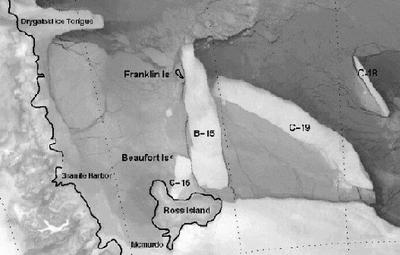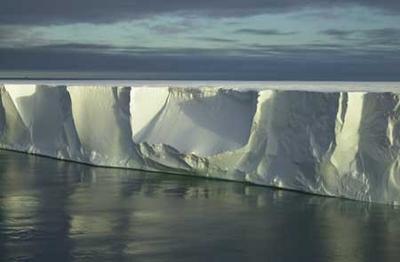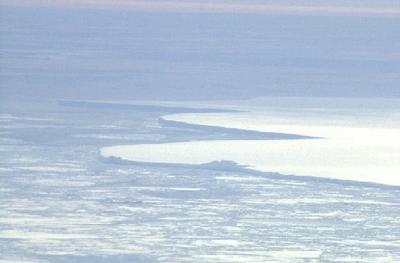15 December, 2004
How is iceberg B-15 affecting McMurdo Station?
The situation with B15 is very interesting; it has broken into smaller bergs, the largest of which is B-15A. The situation is that B-15 broke off the Ross Ice Shelf in 2000 and has been sitting off Ross Island, sheltering the sea ice in McMurdo Sound from waves and ocean currents. Those forces play a major role in the annual breakup of the sea ice up during the austral summer. The result is that the ice hasn't completely broken up for the past few years. Instead, it has grown thicker and it extends much farther out sea than it did before B-15 broke off. The sea ice extended 30 miles out to sea before B-15 broke off and now it extends about 80 miles.
This makes it difficult for icebreakers to do their work of cutting a supply channel for McMurdo and Scott Base, the New Zealand station 1.5 miles from here. The ice in McMurdo Sound is normally 6-10 feet thick during the winter; however, it is now 16-18 feet thick. One of the two icebreakers that cut the supply channel is being repaired and is unavailable to assist with the job this summer. The Polar Star, the other icebreaker, will be here in late December. The challenges it will face alone will be formidable. There have been efforts to contract an icebreaker from another country and we are hopeful this will happen. Supply ships are scheduled to bring fuel and food for next year (2005-2006) in January. If the channel cannot be cut, it will be difficult to move supplies across miles of rotting sea ice to McMurdo...a task both dangerous and difficult. Two years ago they had to pump fuel across several miles of sea ice and they were very successful, with no spills.
The affect of B-15A on wildlife is important too. The benthic communities on the sea floor are not getting the same amount of light and are therefore affected, which in turn affects the entire food chain all the way up to the seals and penguins. Ross Island is the home of the southernmost Adelie and Emperor penguin rookeries. All of these animals depend on fish and access to water to get to them. Penguins have a difficult time without access to open water, as do certain species of seals and orca.
Another consideration is the direct damage done to benthic communities by B-15A. The berg was part of the Ross Ice Shelf, which means it is really thick. It has about 150 feet above sea level, and about nine times as much underwater (1350 feet). Considering the berg is the size of Delaware, when it hits bottom, it can do widespread damage to the benthic communities that have taken eons to develop.
One interesting footnote to this is that the vulcanologists on Mt. Erebus have been recording the scraping sounds from the berg as it hits bottom. They call them "icequakes," and they also occur when two large bergs hit each other. Icequakes have been recorded on seismographs as far away as Tahiti!
Erebus is famous for its Strombolian eruptions, which are characterized by the intermittent explosion or fountaining of basaltic lava from a single vent or crater. Each episode is caused by the release of volcanic gases, and they typically occur every few minutes or so, sometimes rhythmically and sometimes irregularly. The icequakes are causing the bubbles that form in the lava to move to the surface of the lava pool inside the crater much faster. The bubbles do not grow as big, and the eruptions are less dramatic and less frequent. Icequakes have been described as having a "burping" effect on Erebus. If you want to learn more about the work of the vulcanologists on Mt. Erebus, their website contains clips of eruptions and some really cool pictures and a live cam of the lava pool inside the crater: <http://www.ees.nmt.edu/Geop/Erebus/erebus.html>.
Here is a website put up by the glaciologists studying B-15. It has pictures and a good FAQ: <http://amrc.ssec.wisc.edu/iceberg.html>
Here is an interesting current event news arcticle: <http://www.cnn.com/2004/WORLD/asiapcf/12/14/nz.penguins.ap/index.html>

B-15A before the 2004 austral summer

December 3, 2004 B-15A movement (NASA)

The northern edge of B-15 (courtesy of Josh Landis/NSF)

B-15 hit iceberg C16, creating icequakes and "push mounds" along its edges (courtesy Emily Stone /NSF).
Contact the TEA in the field at
.
If you cannot connect through your browser, copy the
TEA's e-mail address in the "To:" line of
your favorite e-mail package.
|
